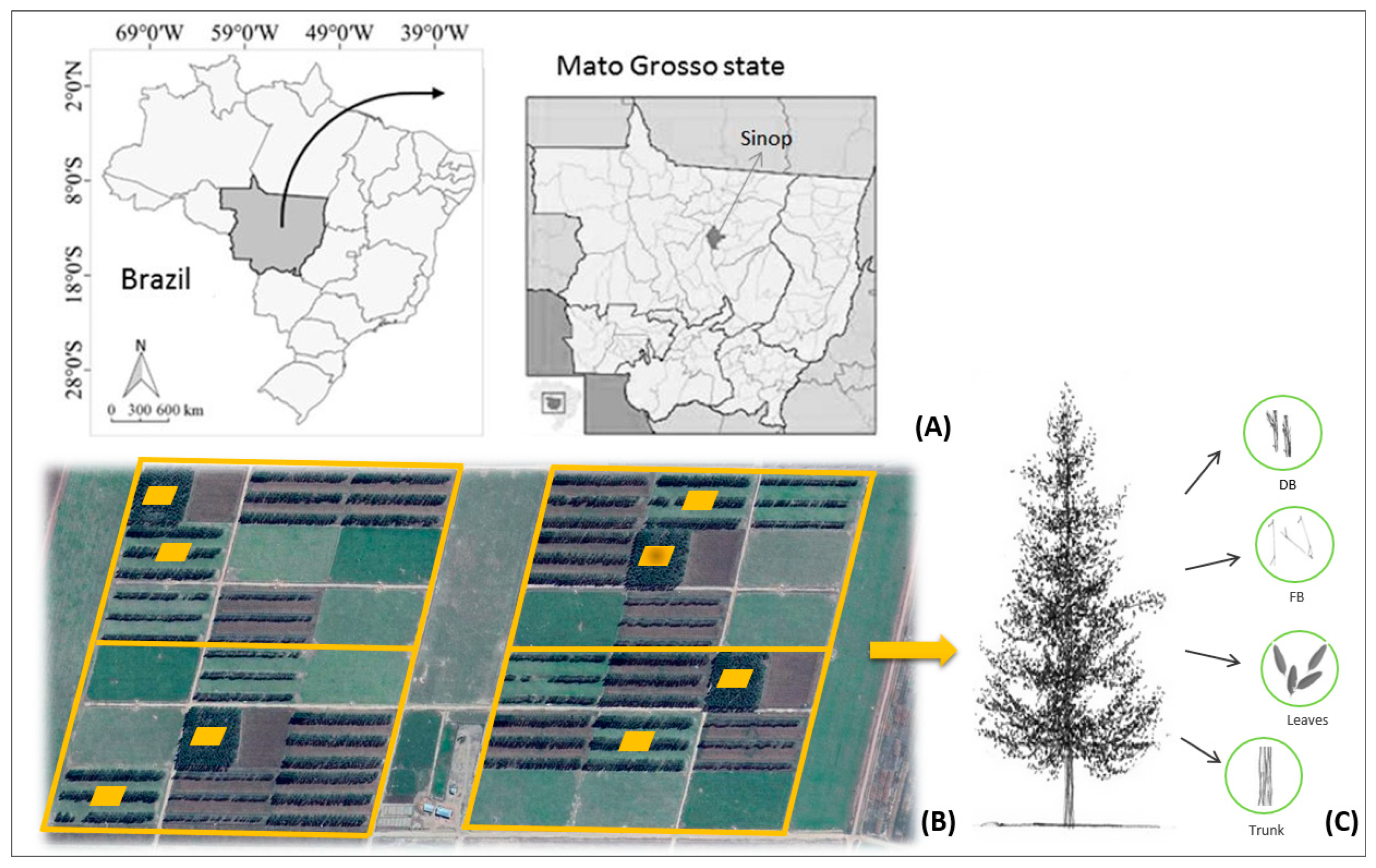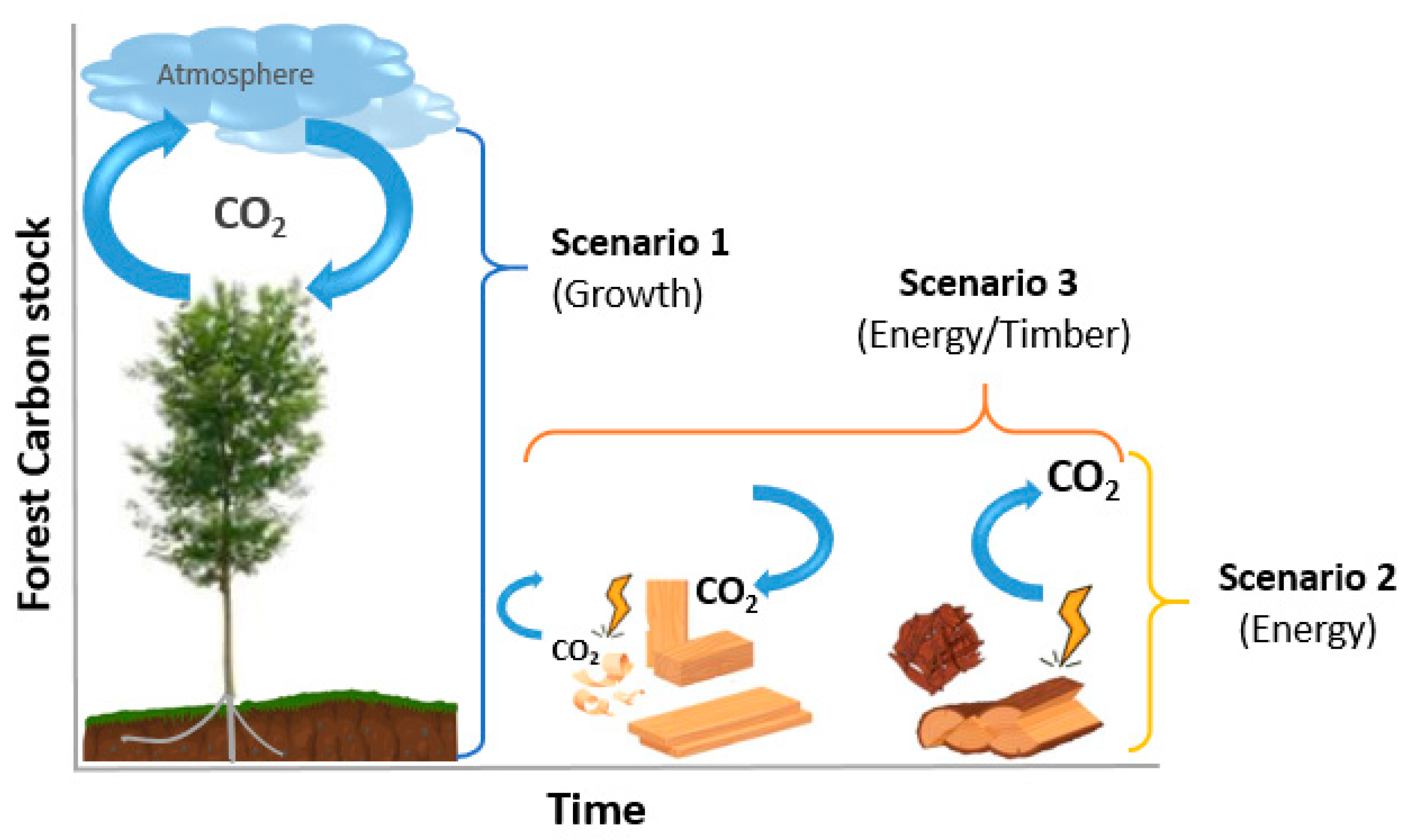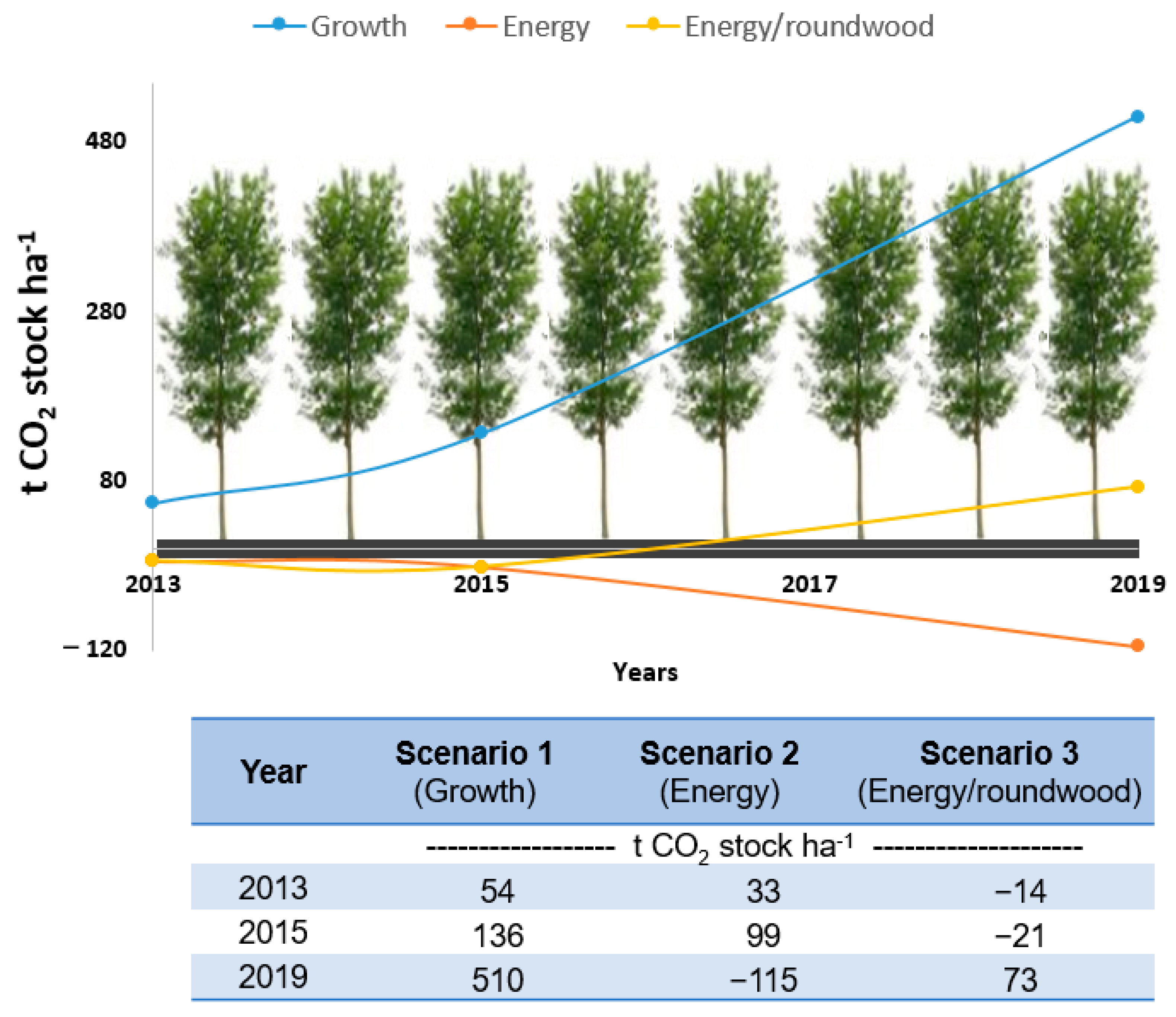Eucalyptus Carbon Stock Research in an Integrated Livestock-Forestry System in Brazil
Abstract
1. Introduction
2. Materials and Methods
2.1. Study Area
2.2. Carbon Dioxide Equivalent Stocks in Three Scenarios
2.2.1. Scenario 1
2.2.2. Scenario 2
2.2.3. Scenario 3
2.3. Statistical Analyses
3. Results and Discussion
3.1. Carbon Stocks in Trees in Monoculture and Livestock-Forestry Integrated Systems
3.2. Three Scenarios for Carbon Dioxide Equivalent Stock in Eucalyptus Monoculture
3.3. Three Scenarios for Carbon Dioxide Equivalent Stock in an Integrated System
3.4. Comparisons and Contrasts to Previous Studies
3.5. Future Research Directions and Challenges
4. Conclusions
Author Contributions
Funding
Institutional Review Board Statement
Informed Consent Statement
Data Availability Statement
Acknowledgments
Conflicts of Interest
References
- Helms, J.A. The Dictionary of Forestry; Society of American Foresters: Bethesda, MD, USA, 1998; pp. 1–210. [Google Scholar]
- Arif, M.; Shahzad, M.K.; Elzaki, E.E.A.; Hussain, A.; Zhang, B.; Yukun, C. Biomass and Carbon Stocks Estimation in Chichawatni Irrigated Plantation in Pakistan. Int. J. Agric. Biol. 2017, 19, 1339–1349. Available online: https://fspublishers.org/ (accessed on 25 April 2023). [CrossRef]
- Zhang, G.Q.; Hui, G.Y.; Hu, Y.B.; Zhao, Z.H.; Guan, X.L.; von Gadow, K.; Zhang, G.G. Designing near-natural planting patterns for plantation forests in China. For. Ecosyst. 2019, 6, 28. [Google Scholar] [CrossRef]
- US Department of Agriculture (USDA). Forest Carbon FAQs. pp. 1–5. Available online: https://www.fs.usda.gov/sites/default/files/Forest-Carbon-FAQs.pdf (accessed on 25 April 2023).
- Penman, J.; Gytarski, M.; Hiraishi, T.; Krug, T.; Kruger, D.; Pipatti, R.; Buendia, L.; Miwa, K.; Ngara, T.; Tanabe, K.; et al. (Eds.) Good Practice Guidance for Land Use, Land-Use Change and Forestry; Institute for Global Environmental Strategies: Hayama, Japan, 2003; pp. 1–590. ISBN 4-88788-003-0. [Google Scholar]
- Árvores, I.B.D. Planted Forests in Brazil and the United Nations Strategic Plan for Forests. 2020. Available online: https://www.un.org/esa/forests/wp-content/uploads/2020/01/Iba.pdf (accessed on 22 March 2023).
- Pezzopane, J.R.M.; Bosi, C.; Nicodemo, M.L.F.; Santos, P.M.; da Cruz, P.G.; Parmejiani, R.S. Microclimate and soil moisture in a silvopastoral system in southeastern Brazil. Bragantia 2015, 74, 110–119. [Google Scholar] [CrossRef]
- Gil, J.; Siebold, M.; Berger, T. Adoption and development of integrated crop-livestock-forestry systems in Mato Grosso, Brazil. Agric. Ecosyst. Environ. 2015, 199, 394–406. [Google Scholar] [CrossRef]
- Skorupa, L.A.; Manzatto, C.V. Sistemas de Integração Lavoura-Pecuária-Floresta no Brasil: Estratégias Regionais de Transferência de Tecnologia, Avaliação da Adoção e de Impactos; Embrapa Environment: Jaguariuna, São Paulo, Brazil, 2019; pp. 1–471. Available online: https://www.embrapa.br/en/busca-de-publicacoes/-/publicacao/1118657/sistemas-de-integracao-lavoura-pecuaria-floresta-no-brasil-estrategias-regionais-de-transferencia-de-tecnologia-avaliacao-da-adocao-e-de-impactos (accessed on 25 April 2023).
- Ministry of Agriculture, Livestock and Food Supply (Ministério da Agricultura, Pecuária e Abastecimento—MAPA). Brazilian Agricultural Policy for Climate Adaptation and Low Carbon Emission: Executive Summary 2020–2030. 2022; pp. 1–36. Available online: https://www.gov.br/mre/pt-br/delbraspar/seminario-brasil-portugal/abcsumarioexecutivo2022ingles_final.pdf (accessed on 22 March 2023).
- Rede ILPF Associates. ICLF in Numbers: 2020/21 Crops. 2020. Available online: https://www.redeilpf.org.br/images/ICLF_in_Numbers-Harvest.pdf (accessed on 21 March 2023).
- West, P.W.; Ratkowsky, D.A. Problems with models assessing influences of tree size and inter-tree competitive processes on individual tree growth: A cautionary tale. J. For. Res. 2022, 33, 565–577. [Google Scholar] [CrossRef]
- Jose, S.; Gillespie, A.R.; Pallardy, S.G. Interspecific interactions in temperate agroforestry. Agrofor. Syst. 2004, 61, 237–255. [Google Scholar] [CrossRef]
- Rivest, D.; Paquette, A.; Moreno, G.; Messier, C. A meta-analysis reveals mostly neutral influence of scattered trees on pasture yield along with some contrasted effects depending on functional groups and rainfall conditions. Agric. Ecosyst. Environ. 2013, 165, 74–79. [Google Scholar] [CrossRef]
- Tonini, H.; Morales, M.M.; Porfirio-da-Silva, V.; Lulu, J.; Neto, A.L.F. Efeito do sistema de plantio e da exposição solar sobre a alocação da biomassa no desenvolvimento inicial do eucalipto. Ciênc. For. 2019, 29, 86–95. [Google Scholar] [CrossRef]
- Peel, M.C.; Finlayson, B.L.; McMahon, T.A. Updated world map of the Koppen-Geiger climate classification. Hydrol. Earth Syst. Sci. 2007, 11, 1633–1644. [Google Scholar] [CrossRef]
- Souza, A.P.; Mota, L.L.; Zamadei, T.; Martin, C.C.; Almeida, F.T.; Paulino, J. Classificação climática e balanço hídrico climatológico no estado de Mato Grosso. Nativa 2013, 1, 34–43. [Google Scholar] [CrossRef]
- Baillie, I.C. Soil Survey Staff 1999, Soil Taxonomy. Soil Use Manag. 2001, 17, 57–60. [Google Scholar] [CrossRef]
- Magalhaes, C.A.S.; Pedreira, B.C.; Tonini, H.; Neto, A.L.F. Crop, livestock and forestry performance assessment under different production systems in the north of Mato Grosso, Brazil. Agrofor. Syst. 2019, 93, 2085–2096. [Google Scholar] [CrossRef]
- Diel, D.; Behling, M.; de Farias Neto, A.L.; Isernhagen, E.C.C. Distribuição horizontal e vertical de fósforo em sistemas de cultivos exclusivos de soja e de integração lavoura-pecuária-floresta. Pesq. Agropec. Bras. 2014, 49, 639–647. [Google Scholar] [CrossRef]
- West, P.W. Stem Volume and Taper Functions. In Tree and Forest Measurement, 3rd ed.; Springer International Publishing: Cham, Switzerland, 2015; Chapter 6; pp. 37–51. [Google Scholar] [CrossRef]
- Gatto, A.; de Barros, N.F.; de Novais, R.F.; da Silva, I.R.; Leite, H.G.; Villani, E.M.D. Carbon stock in the biomass of eucalyptus crops in central-east region of the state of minas gerais—Brazil. Rev. Arvore 2011, 35, 895–905. [Google Scholar] [CrossRef]
- De Carvalho, P.; Domiciano, L.F.; Mombach, M.A.; do Nascimento, H.L.B.; Cabral, L.D.; Sollenberger, L.E.; Pereira, D.H.; Pedreira, B.C. Forage and animal production on palisadegrass pastures growing in monoculture or as a component of integrated crop-livestock-forestry systems. Grass Forage Sci. 2019, 74, 650–660. [Google Scholar] [CrossRef]
- Cardoso, A.S.; Berndt, A.; Leytem, A.; Alves, B.J.R.; de Carvalho, I.D.O.; Soares, L.H.D.; Urquiaga, S.; Boddey, R.M. Impact of the intensification of beef production in Brazil on greenhouse gas emissions and land use. Agric. Syst. 2016, 143, 86–96. [Google Scholar] [CrossRef]
- Environmental Protection Agency (EPA). Wood Residue Combustion in Boilers: AP 42, 5th ed.; EPA: Washington, DC, USA, 2022; Volume 1, pp. 1–20. Available online: https://www3.epa.gov/ttnchie1/ap42/ch01/final/c01s06.pdf (accessed on 21 March 2023).
- CETESB. Plano de Redução de Emissão de Fontes Estacionárias: PREFE 2014; CETESB: São Paulo, Brazil, 2014; pp. 1–199. Available online: https://cetesb.sp.gov.br/ar/wp-content/uploads/sites/28/2015/09/PREFE_2014.pdf (accessed on 22 March 2023).
- Embrapa Forestry. SisILPF-Eucalipto: Software para Manejo de Eucalipto em ILPF; Embrapa Florestas: Colombo, Paraná, Brazil, 2018; Available online: https://www.embrapa.br/en/florestas/transferencia-de-tecnologia/softwares-florestais (accessed on 21 March 2023).
- Jamovi. Open Statistical Software for the Desktop and Cloud. 2023. Available online: https://www.jamovi.org/ (accessed on 21 March 2023).
- Tumer, J.; Lambert, M.J. Nutrient cycling in age sequences of two Eucalyptus plantation species. For. Ecol. Manag. 2008, 255, 1701–1712. [Google Scholar] [CrossRef]
- Morales, M.; Aroca, G.; Rubilar, R.; Acuna, E.; Mola-Yudego, B.; Gonzalez-Garcia, S. Cradle-to-gate life cycle assessment of Eucalyptus globulus short rotation plantations in Chile. J. Clean. Prod. 2015, 99, 239–249. [Google Scholar] [CrossRef]
- Santarosa, E.; Penteado Junior, J.F.; dos Reis Goulart, I.C.G. Transferência de Tecnologia Florestal: Cultivo de Eucalipto em Propriedades Rurais: Diversificação da Produção e Renda; Embrapa Florestas: Colombo, Brazil, 2014; pp. 1–138. Available online: https://ainfo.cnptia.embrapa.br/digital/bitstream/item/121607/1/Apostila-Serie-TT-Eucalipto.pdf (accessed on 25 April 2023).
- Song, C.H.; Woodcock, C.E. A regional forest ecosystem carbon budget model: Impacts of forest age structure and landuse history. Ecol. Model. 2003, 164, 33–47. [Google Scholar] [CrossRef]
- Schweitzer, L. Road ecology: Science and solutions. Environ. Ethics 2005, 27, 109–112. [Google Scholar] [CrossRef]
- Delgado, J.D.; Arroyo, N.L.; Arevalo, J.R.; Fernandez-Palacios, J.M. Edge effects of roads on temperature, light, canopy cover, and canopy height in laurel and pine forests (Tenerife, Canary Islands). Landsc. Urban Plan. 2007, 81, 328–340. [Google Scholar] [CrossRef]
- Sandoval, S.; Cancino, J. Modeling the edge effect in even-aged Monterrey pine (Pinus radiata D. Don) stands incorporating a competition index. For. Ecol. Manag. 2008, 256, 78–87. [Google Scholar] [CrossRef]
- Van Fan, Y.; Klemes, J.J.; Ko, C.H. Bioenergy carbon emissions footprint considering the biogenic carbon and secondary effects. Int. J. Energy Res. 2021, 45, 283–296. [Google Scholar] [CrossRef]
- Hartl, F.H.; Hollerl, S.; Knoke, T. A new way of carbon accounting emphasises the crucial role of sustainable timber use for successful carbon mitigation strategies. Mitig. Adapt. Strateg. Glob. Chang. 2017, 22, 1163–1192. [Google Scholar] [CrossRef]
- Lopes, L.B.; Eckstein, C.; Pina, D.S.; Carnevalli, R.A. The influence of trees on the thermal environment and behaviour of grazing heifers in Brazilian Midwest. Trop. Anim. Health Prod. 2016, 48, 755–761. [Google Scholar] [CrossRef]
- Herbut, P.; Hoffmann, G.; Angrecka, S.; Godyn, D.; Vieira, F.M.C.; Adamczyk, K.; Kupczynski, R. The effects of heat stress on the behaviour of dairy cows—A review. Ann. Anim. Sci. 2021, 21, 385–402. [Google Scholar] [CrossRef]
- Fan, C.Y.; Su, D.; Tian, H.; Hu, R.T.; Ran, L.; Yang, Y.; Su, Y.J.; Cheng, J.B. Milk production and composition and metabolic alterations in the mammary gland of heat-stressed lactating dairy cows. J. Integr. Agric. 2019, 18, 2844–2853. [Google Scholar] [CrossRef]
- Lucchese-Cheung, T.; de Aguiar, L.K.; de Lima, L.C.; Spers, E.E.; Quevedo-Silva, F.; Alves, F.V.; de Almeida, R.G. Brazilian Carbon Neutral Beef as an Innovative Product: Consumption Perspectives Based on Intentions’ Framework. J. Food Prod. Mark. 2021, 27, 384–398. [Google Scholar] [CrossRef]
- dos Reis, J.C.; Kamoi, M.Y.T.; Michetti, M.; Wruck, F.J.; de Aragão Ribeiro Rodrigues, R.; de Farias Neto, A.L. Economic and environmental impacts of integrated systems adoption in Brazilian agriculture-forest frontier. Agrofor. Syst. 2023, 97, 1–17. [Google Scholar] [CrossRef]
- Hoshide, A.K. Back to the Future: Agricultural Booms, Busts, and Diversification in Maine, USA, 1840–2017. Sustainability 2022, 14, 15907. [Google Scholar] [CrossRef]
- Molossi, L.; Hoshide, A.K.; de Abreu, D.C.; de Oliveira, R.A. Agricultural Support and Public Policies Improving Sustainability in Brazil’s Beef Industry. Sustainability 2023, 15, 4801. [Google Scholar] [CrossRef]
- Silva, C.A.; Klauberg, C.; Carvalho, S.; Piccolo, M.D.; Rodriguez, L.C.E. Carbon stock in aboveground forest biomass in commercial Eucalyptus spp. plantation. Sci. For. 2015, 43, 135–146. [Google Scholar]
- Singh, A.; Singh, P.; Dhillon, G.P.S.; Sharma, S.; Singh, B.; Gill, R.I.S. Differential impacts of soil salinity and water logging on Eucalyptus growth and carbon sequestration under mulched vs. unmulched soils in south-western Punjab, India. Plant Soil 2023, 482, 401–425. [Google Scholar] [CrossRef]
- Premetilake, M.; Perera, G.A.D.; Kulasooriya, S.A.; Ratnayake, R.R. Variation in above and below ground carbon storage in a Eucalyptus grandis plantation established in a grassland with a chronosequence of age. Trop. Ecol. 2023, 1–11. [Google Scholar] [CrossRef]
- Booth, M.S. Not carbon neutral: Assessing the net emissions impact of residues burned for bioenergy. Environ. Res. Lett. 2018, 13, 035001. [Google Scholar] [CrossRef]
- De Figueiredo, E.B.; Jayasundara, S.; Bordonal, R.D.; Berchielli, T.T.; Reis, R.A.; Wagner-Riddle, C.; La Scala, N. Greenhouse gas balance and carbon footprint of beef cattle in three contrasting pasture-management systems in Brazil. J. Clean. Prod. 2017, 142, 420–431. [Google Scholar] [CrossRef]
- Pazhavand, Z.; Sadeghi, H. Using fig and eucalyptus for ecosystem restoration and management: Good choices with carbon storage ability. Environ. Sci. Pollut. Res. 2020, 27, 31615–31622. [Google Scholar] [CrossRef]
- das Neves, C.M.N.; Silva, M.L.N.; Curi, N.; Macedo, R.L.G.; Tokura, A.M. Carbon stock in agricultural-forestry-pasture, planted pasture, and eucalyptus systems under conventional tillage in the northwestern region of the Minas Gerais State. Cienc. Agrotecnol. 2004, 28, 1038–1046. [Google Scholar] [CrossRef]
- Molossi, L.; Hoshide, A.K.; Pedrosa, L.M.; Oliveira, A.S.; Abreu, D.C. Improve pasture or feed grain?: Greenhouse gas emissions, profitability, and resource use for Nelore beef cattle in Brazil’s Cerrado and Amazon biomes. Animals 2020, 10, 1386. [Google Scholar] [CrossRef]
- Pereira, C.H.; Patino, H.O.; Hoshide, A.K.; Abreu, D.C.; Rotz, C.A.; Nabinger, C. Grazing supplementation and crop diversification benefits for southern Brazil beef: A case study. Agric. Syst. 2018, 162, 1–9. [Google Scholar] [CrossRef]
- Giongo, M.; Santos, M.M.; da Silva, D.B.; Cachoeira, J.N.; Santopuoli, G. Climate-Smart Forestry in Brazil. In Climate-Smart Forestry in Mountain Regions; Managing Forest Ecosystems Book Series; Tognetti, R., Smith, M., Panzacchi, P., Eds.; Springer International Publishing AG: Cham, Switzerland, 2021; Volume 40, pp. 545–570. [Google Scholar] [CrossRef]
- Cardozo, E.G.; Celentano, D.; Rousseau, G.X.; e Silva, H.R.; Muchavisoy, H.M.; Gehring, C. Agroforestry systems recover tree carbon stock faster than natural succession in Eastern Amazon, Brazil. Agrofor. Syst. 2022, 96, 941–956. [Google Scholar] [CrossRef]
- Zolin, C.A.; da Silva Matos, E.; de Souza Magalhães, C.A.; Paulino, J.; Lal, R.; Spera, S.T.; Behling, M. Short-term effect of a crop-livestock-forestry system on soil, water and nutrient loss in the Cerrado-Amazon ecotone. Acta Amaz. 2021, 51, 102–112. [Google Scholar] [CrossRef]
- Kraeski, A.; de Almeida, F.T.; de Souza, A.P.; de Carvalho, T.M.; de Abreu, D.C.; Hoshide, A.K.; Zolin, C.A. Land Use Changes in the Teles Pires River Basin’s Amazon and Cerrado Biomes, Brazil, 1986–2020. Sustainability 2023, 15, 4611. [Google Scholar] [CrossRef]
- dos Reis, J.A.V.; Hoshide, A.K.; Vreyens, J.R.; de Oliveira, A.S.; de Barros, V.A.M.; da Silva, W.M.; Molossi, L.; Viana, J.L.; de Abreu, D.C.; de Oliveira, R.A. Training Sources and Preferences for Agricultural Producers and Professionals in Middle-North Mato Grosso, Brazil. Sustainability 2023, 15, 4712. [Google Scholar] [CrossRef]





| System/Parameters 1 | pH | P | K | Ca | Mg | Al | H + Al | CEC | SB | V |
|---|---|---|---|---|---|---|---|---|---|---|
| mg dm−3 | cmolcdm−3 | % | ||||||||
| Monoculture (F) | 5.17 (±0.17) | 6.78 (±1.09) | 15.8 (±5.05) | 1.68 (±0.39) | 0.66 (±0.11) | 0.00 (±0.00) | 5.7 (±0.76) | 8.07 (±0.57) | 2.38 (±0.45) | 29.86 (±6.15) |
| Integrated Livestock-Forestry (ILF-Eucalyptus) | 5.15 (±0.22) | 3.99 (±1.13) | 16.97 (± 4.75) | 2.21 (± 0.74) | 0.63 (±0.11) | 0.00 (±0.00) | 4.84 (±1.03) | 7.72 (±1.40) | 2.88 (±0.77) | 37.61 (±7.69) |
Disclaimer/Publisher’s Note: The statements, opinions and data contained in all publications are solely those of the individual author(s) and contributor(s) and not of MDPI and/or the editor(s). MDPI and/or the editor(s) disclaim responsibility for any injury to people or property resulting from any ideas, methods, instructions or products referred to in the content. |
© 2023 by the authors. Licensee MDPI, Basel, Switzerland. This article is an open access article distributed under the terms and conditions of the Creative Commons Attribution (CC BY) license (https://creativecommons.org/licenses/by/4.0/).
Share and Cite
Morales, M.M.; Tonini, H.; Behling, M.; Hoshide, A.K. Eucalyptus Carbon Stock Research in an Integrated Livestock-Forestry System in Brazil. Sustainability 2023, 15, 7750. https://doi.org/10.3390/su15107750
Morales MM, Tonini H, Behling M, Hoshide AK. Eucalyptus Carbon Stock Research in an Integrated Livestock-Forestry System in Brazil. Sustainability. 2023; 15(10):7750. https://doi.org/10.3390/su15107750
Chicago/Turabian StyleMorales, Marina Moura, Hélio Tonini, Maurel Behling, and Aaron Kinyu Hoshide. 2023. "Eucalyptus Carbon Stock Research in an Integrated Livestock-Forestry System in Brazil" Sustainability 15, no. 10: 7750. https://doi.org/10.3390/su15107750
APA StyleMorales, M. M., Tonini, H., Behling, M., & Hoshide, A. K. (2023). Eucalyptus Carbon Stock Research in an Integrated Livestock-Forestry System in Brazil. Sustainability, 15(10), 7750. https://doi.org/10.3390/su15107750









